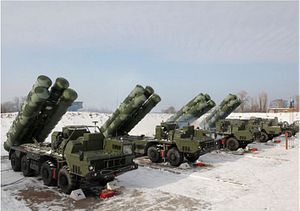Russian state-owned arms maker Almaz-Antey has delivered its last S-400 Triumf long-range air defense (NATO reporting name: SA-21 Growler) regiment for 2018 to the Russian armed forces ahead of schedule, the company said in a November 2 press statement.
As usual, the S-400 induction ceremony was held at the Kapustin Yar training range in the Astrakhan Region, according to the statement. The acceptance into service was preceded by a last round of user trials that included the successful interception of multiple aerial targets. “Acceptance trials were successful,” the Russian state-owned defense company said.
The new unit brings the total number of deployed S-400 regiments currently in service with the Russian armed forces to 27, according to a Diplomat count. Overall, the Russian Ministry of Defense accepted a total of four S-400 regiments into service in 2o18. The military last took delivery of an S-400 regiment in October; previous deliveries took place in August and July. As I explained in August:
An S-400 regiment is divided up into two battalions (also called divisions in the Russian military), which in turn are split into two batteries. A battery can consist of up to 12 transporter erector launchers (TELs), although 4 to 8 TELs per unit are more common. In addition to the TELs, each battery includes a long-range surveillance radar, a target acquisition and engagement (fire control) radar systems and a command post, as well as an additional fire control radar system.
In a boost to the military’s anti-access/aerial denial capabilities, the Russian MOD expects to deploy at least 56 S-400 battalions or 28 regiments by 2020. The S-400 has not been deployed in actual combat but is considered to be one of the most advanced interceptor-based long-range air defense systems in the world. It reportedly is capable of engaging up to 36 targets simultaneously and can be armed with a host of different missiles. As I explained elsewhere:
In comparison to its predecessor, the S-300, the S-400 air defense system features an improved radar system and updated software; it can purportedly fire four new types of surface-to-air (SAM) missiles in addition to the S-300’s 48N6E, a vertical tube launched, solid fuel, single stage SAM with an estimated range of 150 kilometers (93 miles), and the improved 48N6E2 missile with a reported range of 195 kilometers (121 miles).
(…)
The S-400 is also armed with an improved variant of the 48N6E2 with an alleged range of 250 kilometers (160 miles). The air defense system can also fire two additional missiles, the 9M96E and 9M96E2 with respective ranges of 40 km (25 miles) and 120 km (75 miles). Improved S-300 air defense systems such as the S-300PMU-2 Favorite … can purportedly also fire the 9M96E and 9M96E2.
The S-400 can reportedly fire missiles at a rate 2.5 times faster the S-300 and be used against a wide array of aerial targets, including stand-off jammer aircraft, Airborne Warning and Control System (AWACS) aircraft, as well as ballistic and cruise missiles.
Notably, the S-400’s most advanced long-range missile, the 40N6 SAM, was accepted into service last month.































